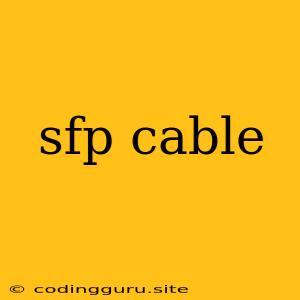What is an SFP Cable?
An SFP cable, short for Small Form-factor Pluggable, is a crucial component in networking infrastructure, facilitating high-speed data transmission between network devices. You might be asking, "What makes this cable so special?" Well, let's break down its key features and understand why it's a popular choice for various networking applications.
SFP Cable: A Closer Look
An SFP cable is a compact transceiver module that plugs into network devices, such as switches, routers, and media converters, allowing them to connect to different types of optical fiber. Think of it as a specialized connector that allows you to adapt your network gear for different types of fiber optic cabling.
What are the benefits of using SFP cables?
- Versatility: SFP cables support a wide range of data rates and fiber types, making them adaptable to various networking needs. You can use them for Gigabit Ethernet (1000Base-X), Fast Ethernet (100Base-X), Fibre Channel (FC), and even 10 Gigabit Ethernet (10GBase-X).
- Hot-Swappable: One of the major advantages of SFP cables is their hot-swappable feature. This means you can replace or upgrade them without powering down the entire network device.
- Cost-Effective: While SFP cables might be more expensive than traditional copper cables, they offer a lower cost per bit transmitted over longer distances. This makes them a more cost-effective solution for high-bandwidth networks.
- Compact Size: SFP cables are designed with a small form factor, allowing for dense port configurations on network devices. This is especially useful for data centers and other space-constrained environments.
SFP Cable Types: A Variety of Choices
SFP cables come in various types, each tailored to different fiber optic cable standards. Here are some of the most common types:
- SFP-1G-SX: This SFP cable supports 1000Base-SX, which uses multimode fiber (MMF) for short-distance data transmission.
- SFP-1G-LX: This SFP cable supports 1000Base-LX, which uses single-mode fiber (SMF) for long-distance data transmission.
- SFP-1G-T: This SFP cable supports 1000Base-T, which uses copper cabling for short-distance data transmission.
- SFP+: This SFP cable supports 10GBase-X, which uses fiber optics for high-speed data transmission.
Choosing the right SFP cable type depends on factors such as the distance you need to cover, the data rate you require, and the type of fiber optic cable you're using.
SFP Cable: Tips for Choosing the Right One
- Understand your network requirements: Before buying an SFP cable, determine your network's needs, including the required data rate, the distance you need to cover, and the type of fiber optic cable you'll be using.
- Check device compatibility: Ensure that the SFP cable you choose is compatible with your network devices. Check the device's specifications for supported SFP module types.
- Consider future scalability: Choose an SFP cable that can handle future network upgrades. This means considering data rates and distance requirements for future expansion.
- Look for certified cables: Opt for SFP cables that are certified by reputable organizations. This ensures quality and reliability for your network infrastructure.
SFP Cable: A Key to High-Performance Networks
SFP cables are essential components for modern high-performance networks. They offer versatility, reliability, and cost-effectiveness for various networking applications. Understanding SFP cable types, choosing the right one, and ensuring compatibility with your network devices will ensure smooth and efficient data transmission.
Kesimpulan
SFP cables are small but powerful connectors that enable high-speed data transmission in modern networks. Their versatility, hot-swappable nature, and cost-effectiveness make them a crucial component for efficient and reliable networking. Choosing the right SFP cable for your needs is crucial for maximizing network performance.
